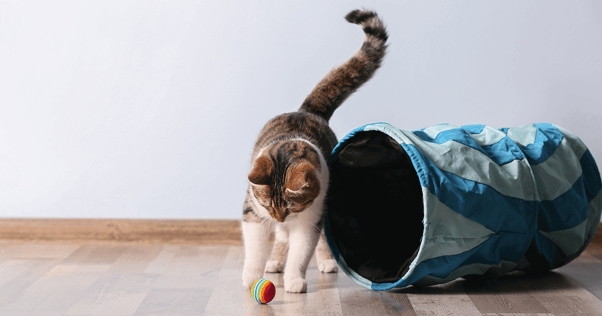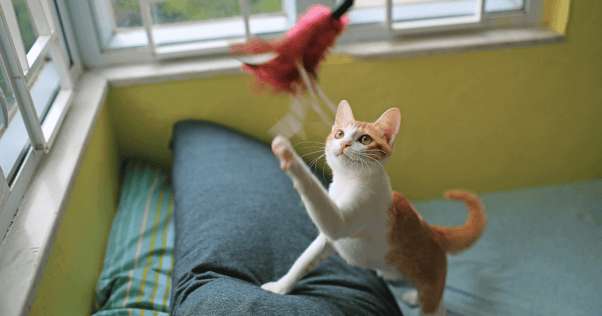How Much Exercise Do Cats Need?
It’s a common question amongst us cat-lovers, particularly for those whose cats live indoors: “Just how much exercise do cats need?” Like us humans, regular exercise is crucial to a cat’s physical health and mental well-being. However, knowing whether our cats are exercising enough can be tricky! With that in mind, we thought we’d bring this subject up for discussion and share a few tips on understanding your cat’s exercise needs. Plus, we’re also discussing why some cats may have more energy than others!
Daily Exercise For A Happy Cat
How much exercise do cats need? Well, the strictest answer is that there isn’t one. Every cat is an individual with their own unique needs, so what may be suitable for one may not be appropriate for another. Of course, this isn’t the most helpful information without a benchmark to aim for, but there is fortunately a general rule of thumb for cat exercise we can follow: the 30-minute rule.
For most indoor cats, a minimum of 30 minutes of moderate exercise daily is suitable to keep them content and happy. That said, it’s important to remember that cats are natural hunters. In the wild, they would indulge in short bursts of energy, often leaping, chasing, and pouncing on their prey. This activity wouldn’t be limited to one 30-minute stretch but would be scattered throughout their day. Likewise, we shouldn’t aim to give domesticated cats all their exercise in one go! Instead, a sensible starting point is to break those 30 minutes down into two sessions of 15 minutes each. This regular activity is great for keeping cats fit, mentally stimulated, and at a healthy weight.

So, while some cats may be content exploring out in the wild, what’s the best way to ensure our indoor cats’ exercise needs are being met? Keep reading to discover our tips explaining how to exercise a cat.
Cat Playtime
Play is one of the best sources of exercise for indoor cats, and it’s also a fantastic way to build a strong bond between you and your feline friend! Just remember that every cat has its own toy preference. Whether it’s a ball, a fishing rod toy, a wind-up mouse, or just a simple cardboard box, the key is to find what captivates your cat’s attention. It's essential to give your cat time to rest between sessions, and it’s best to end on a positive note – ideally with them ‘catching’ something.
You should also ensure your play sessions only take place when your cat is feeling calm and isn’t tired, as this can otherwise transform an innocent play session into a source of stress and anxiety in cats. Good times to play are typically at the start and end of the day, matching a cat’s crepuscular nature. If you have multiple cats, it might be beneficial to separate their play sessions to cater for their individual preferences.

Equally, you should never use your fingers or feet as a substitute for a toy during your cat’s exercise sessions. While it might seem harmless in kittens, it can lead to some painful scratches and bites as they grow!
Other Ways To Keep Your Cat Active
- Multi-level Environment – Creating a multi-dimensional space with ramps, walkways, and elevated spots encourages climbing and exploration, which provides an excellent form of cat exercise.
- Scratching Objects – Scratching is a natural cat behaviour. Vertical posts wrapped in sisal rope are a popular choice and certainly provide a better option than your furniture!
- Controlled Outdoor Access – If feasible, providing controlled access to the outdoors can be a great way to exercise indoor cats. Cat-fenced gardens or patios (sometimes known as Catios) can give your cat the thrill of the outside world while ensuring their safety.
- Puzzle Toys & Feeders – These toys and feeders stimulate both the mind and body. They mimic the natural hunting instinct, making your cat work for its food.
- Training – Believe it or not, you can train your cat! From simple tricks to healthcare-related actions, training can be both fun and practical.
On the lookout for more tips on how to exercise a cat? We have a whole article on the subject that you can find here!

Energetic Cats – A Sign Of Under Stimulation?
If your cat is showing regular signs of high energy, this could be an indication of boredom or frustration and may be linked to seeing signs of anxiety and stress in cats. Besides regular physical activity, mental stimulation plays a significant role in keeping your cat calm which is why activities such as puzzle toys and training can be so effective.
FELIWAY Optimum can also be a great aid for relieving signs of cat anxiety and stress. This simply plugs into an electrical socket in your home and steadily releases pheromones that have been bioengineered to enhance a cat’s serenity. Alongside regular exercise and a healthy lifestyle, FELIWAY Optimum can be effective for helping cats to feel comfortable and secure in their home.
Are you interested in learning more about your cat’s exercise needs or want to find more information on FELIWAY Optimum? Please don’t hesitate to get in touch! We’d love to hear from you and share all the advice we can. You can also stay informed with all the latest information about FELIWAY Optimum and all our products by signing up to our newsletter.
